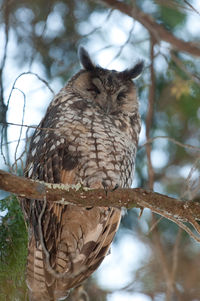Abyssinian Owl
 From Conservapedia
From Conservapedia | Abyssinian Owl | |
|---|---|

| |
| Scientific classification | |
| Kingdom Information | |
| Domain | Eukaryota |
| Kingdom | Animalia |
| Subkingdom | Bilateria |
| Branch | Deuterostomia |
| Phylum Information | |
| Phylum | Chordata |
| Sub-phylum | Vertebrata |
| Infraphylum | Gnathostomata |
| Class Information | |
| Superclass | Tetrapoda |
| Class | Aves |
| Sub-class | Neornithes |
| Infra-class | Neoaves |
| Order Information | |
| Order | Strigiformes |
| Family Information | |
| Family | Strigidae |
| Sub-family | Striginae |
| Genus Information | |
| Genus | Asio |
| Species Information | |
| Species | A. abyssinicus |
| Population statistics | |
| Conservation status | Least concern[1] |
The Abyssinian owl (Asio abyssinicus) is a species of owl inhabiting the forested areas of east-central Africa.
Description[edit]
The Abyssinian owl is up to 17 inches in length and 30 inches in wingspan. Despite being darker in color, it bears a similar appearance to the related long-eared owl (Asio otus); some authorities list the Abyssinian owl as a subspecies of A. otis. The Abyssinian owl has a buff-rufous or tawny facial disc that is pale to dark, with distinctive light grey eyebrows, yellow eyes and a dark bill. The ear tufts are also dark brown with white edging.
Subspecies[edit]
- Asio abyssinicus abyssinicus; Eritrean and Ethiopian highlands
- Asio abyssinicus graueri; Democratic Republic of the Congo: (Ruwenzori Mountains, Mt. Kabobo); Kenya (Mt. Kenya)
Abyssinian owls inhabit heath and open grasslands, wetlands, open wooded areas, damp forest valleys and gorges, from sea level to an elevation of up to 12,800 feet.
They are active at dawn as well as at night. Diet consists of small mammals, birds, and reptiles. Reproduction is largely unknown; however, it is clear that it is territorial and that it often places its nest in the abandoned nests of other birds.
References[edit]
- ↑ http://www.iucnredlist.org/details/22689512/0
Categories: [Birds] [Birds of Prey] [Owls] [Eared Owls]
↧ Download as ZWI file | Last modified: 02/18/2023 04:17:18 | 41 views
☰ Source: https://www.conservapedia.com/Abyssinian_Owl | License: CC BY-SA 3.0
 ZWI signed:
ZWI signed: KSF
KSF